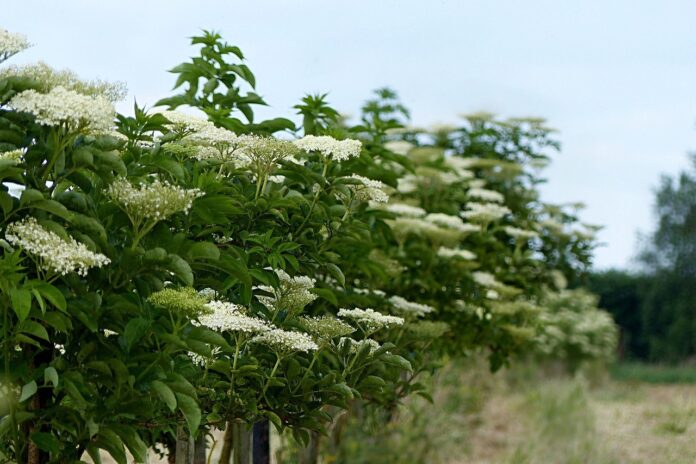I recently wrote about gardening for climate change and adapting to changing precipitation patterns and periods of drought from a general standpoint. However, thinking about the way the weather has changed more locally, in Northeast Ohio, it definitely seems to be wetter more consistently and for longer periods of time. Logically, those of us with wet yards need to consider planting trees, shrubs and groundcovers that are more tolerant to wet conditions.
Not all plants grow well in wet areas
Many plants struggle to grow when soil is constantly wet because their roots require oxygen and saturated soil has no room for air. Trees and shrubs may be able to survive but often experience weak root growth and grow poorly as a result. These plants will also be more susceptible to soil-borne diseases and other issues.
Defining a wet area
A wet area constitutes more than an area of land that is wet all of the time year-round. Sloped sites are not always well-drained and can be considered wet when the soil is composed of a high clay content or it has a high water table and holds too much water. Other sites may appear well-drained for most of the year, but could still be too wet to support many trees or shrubs. These sites typically drain slowly and stay wet for extended periods of time when rain is abundant in the spring and fall.
Amending the soil
Soil amendments only relieve soil moisture problems if the entire root zone of a mature plant can be altered, which means amending the soil in tree planting holes is often ineffective and sometimes destructive.
However, trees can be planted with as much as ⅓ of their root balls above the soil line and loam soil and organic matter can be added on top of the existing soil to establish them on marginally well-drained soil.
Gardens and beds where shrubs are planted can be amended by adding organic matter such as compost, peat and composted sludge.
Sand is ineffective in improving drainage when less than 50 percent of the soil is composed of sand, which makes it a poor soil amendment.
Native trees tolerant to wet conditions
- American arborvitae
- American holly
- American hornbeam
- American larch
- American snowbell
- Ash trees – black ash, blue ash, green ash, pumpkin ash and wafer ash
- Aspen
- Birch trees – gray birch, river birch and yellow birch
- Black gum
- Catberry
- Common hackberry
- Common persimmon
- Common serviceberry
- Common winterberry
- Cucumber tree
- Eastern Cottonwood
- Gray Alder
- Hawthorn trees – bigfruit hawthorn, broadleaf hawthorn, fireberry hawthorn, fleshy hawthorn, Holmes’ hawthorn, Quebec hawthorn and waxyfruit hawthorn
- Maple trees – red maple and silver maple
- Northern arrowwood
- Oak trees – bur oak, pin oak and swamp white oak
- Poison sumac
- Red Elderberry
- Shellbark hickory
- Southern Catalpa
- Sycamore
- Thornless honeylocust
- Willow trees – autumn willow, black willow, meadow willow, peachleaf willow, silky willow
Native shrubs tolerant to wet conditions
- Alderleaf buckthorn
- Arrowwood viburnum
- Black chokeberry
- Black Huckleberry
- Bog birch
- Bog rosemary
- Carolina rose
- Cranberry – American cranberrybush, large cranberry and small cranberry
- Common buttonbush
- Common ninebark
- Creeping snowberry
- Elderberry
- Gray dogwood
- Highbush blueberry
- Labrador tea
- Leatherleaf
- Maleberry
- Marshmallow hibiscus
- Mountain fly honeysuckle
- Northern bayberry
- Northern spicebush
- Pink azalea
- Pinxterbloom azalea
- Possumhaw Viburnum
- Red chokeberry
- Red osier dogwood
- Silky dogwood
- Smooth alder
- Summersweet
- Swamp fly honeysuckle
- Swamp rose
- Sweetgale
- Sweetshrub
- Twinflower
- White meadowsweet
- Whiterod viburnum
- Wild rhododendron
- Willows – bog willow, gray willow, Missouri river willow, prairie willow, sageleaf willow and sandbar willow
- Winterberry
Native groundcovers tolerant to wet conditions
- Turtlehead
- Daylily
- Primrose
- Foam flower
- American globeflower
- Blue marsh violet
- False violet
- Bog white violet
- Striped violet
- Yellowroot
Always check a plant’s native distribution before planting it on your property and avoid accidentally planting invasive species. Lady Bird Johnson Wildflower Center has a comprehensive database you can use.












Hi Sara,
Thanks for the article. Do you know of any seed or tree planting programs that offer these trees etc. That you mentioned? I’d like to plant diversity to prepare for future climate changes.
Stephanie Nelson
Stephanie,
I’m not sure where you’re at, but Ohio Prairie Nursery ships seed mixes for specific soil conditions and the soil and water conservation district in your county likely holds an annual native plant sale, tree sale or both. Those are the places I would start. Best of luck to you!